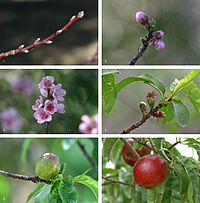
A fruit is a ripened ovary. Inside the ovary is one or more ovules where the megagametophyte contains the mega gamete or egg cell.[9] The ovules are fertilized in a process that starts with pollination, which involves the movement of pollen from the stamens to the stigma of flowers. After pollination, a tube grows from the pollen through the stigma into the ovary to the ovule and sperm are transferred from the pollen to the ovule, within the ovule the sperm unites with the egg, forming a diploid zygote. Fertilization in flowering plants involves both plasmogamy, the fusing of the sperm and egg protoplasm and karyogamy, the union of the sperm and egg nucleus. When the sperm enters the nucleus of the ovule and joins with the megagamete and the endosperm mother cell, the fertilization process is completed. As the developing seeds mature, the ovary begins to ripen. The ovules develop into seeds and the ovary wall, the pericarp, may become fleshy (as in berries or drupes), or form a hard outer covering (as in nuts). In some cases, the sepals, petals and/or stamens and style of the flower fall off. Fruit development continues until the seeds have matured. In some multiseeded fruits, the extent to which the flesh develops is proportional to the number of fertilized ovules.[12] The wall of the fruit, developed from the ovary wall of the flower, is called the pericarp. The pericarp is often differentiated into two or three distinct layers called the exocarp (outer layer, also called epicarp), mesocarp (middle layer), and endocarp (inner layer). In some fruits, especially simple fruits derived from an inferior ovary, other parts of the flower (such as the floral tube, including the petals, sepals, and stamens), fuse with the ovary and ripen with it. The plant hormone ethylene causes ripening. When such other floral parts are a significant part of the fruit, it is called an accessory fruit. Since other parts of the flower may contribute to the structure of the fruit, it is important to study flower structure to understand how a particular fruit forms.
No comments:
Post a Comment